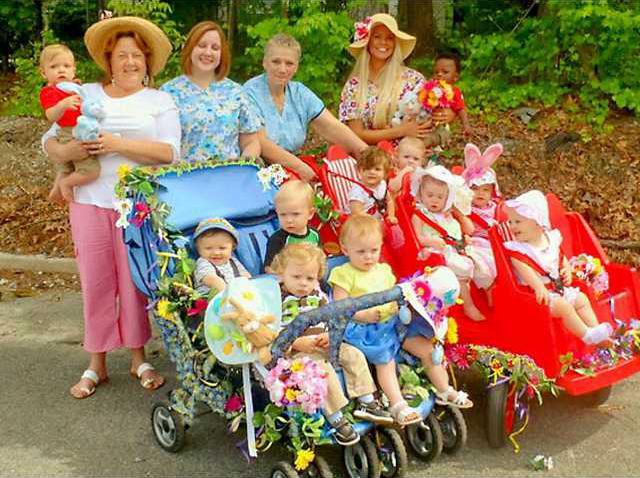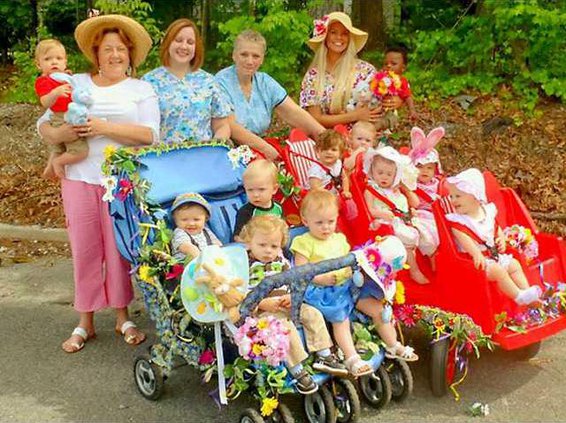Tie on an Easter bonnet and leave the doldrums of winter behind. Easter eggs, the Easter bunny and Easter celebrations coincide with the beginning of spring – a time for renewal of the Christian faith.
The tradition of wearing hats as a part of the Easter holiday started long ago. The hats often were large and decorated with ribbons, flowers and lace. Actually, the first Easter bonnets were wreaths of leaves and flowers. In the depths of the Great Depression, a new Easter hat was a luxury.
When I was a child, Easter meant getting a new dress, gloves, white sandals and a frilly hat with soft lavender flowers. From bunnies and eggs to flowers and jellybeans, things haven’t really changed much. Children still love to dress up, and parents are eager to take their pictures.
Recently, I was charmed by a group of happy children dressed in bright colors, Easter frills and hats. I was drawn to them as if I somehow had stumbled upon a little girl I knew many years ago. It was an Easter parade at a local day care.
They were so beautiful I couldn’t resist getting a closer look. The sun-kissed faces of giggling children, the smell of jasmine and the warm breeze blowing in from the Atlantic were intoxicating. A sense of déjà vu swept over me; for a brief, magical moment, I was one of them.
The day care’s director Patrice Black was walking with the children. To my delight, she graciously invited me to join the children’s parade. As I savored every step of the special walk, Black explained how the children are taught our culture, traditions and appreciation for every holiday, including wearing Easter hats. I especially liked the ones with lavender flowers.
As Ivey Spence and Otis DeVillars know, traditions can strengthen our bonds of friendship. We can stay connected to each other across a lifetime. I was spellbound listening as the 78-year-old men talked about their childhood memories, especially of Easter, and a friendship spanning 75 years.
They grew up in Keller and were childhood playmates within walking distance of each other’s houses. Spence talked about where his family resided.
“We lived in the old John Davis house – over there where Barefoot Betty used to live. Mitchell’s store was later built close to the house. I guess you could say we lived at Tivoli.” Spence’s parents were Ivy and Ellie Davis Spence.
Elaborating a bit more, Spence said, “At the time, John Davis was living down at the Cottonham place. He was the ‘keeper’ because the Cottonhams didn’t stay there the whole year. When Henry Ford bought it, John had to move. That’s when we had to move out of his house and went across the Tivoli River.”
Spence is proud to call Bryan County home. With his typical big smile, he said, “I ain’t never had but two addresses in my life – the military address and the Richmond Hill address.” Spence and his wife, Anna, still live in Keller.
DeVillars was born in Ways, Ga., to Ed DeVillars and Mabel Campbell. (His mother’s name is pronounced May Belle.) They lived in Dunham Swamp, known today as Dunham Marsh.
Remembering his old home, DeVillars’ eyes took on a faraway look.
When he spoke again, his voice was somber and earnest: “No one these days wants to say they live in a ‘swamp.’ To me, it will always be Dunham Swamp. I ride down there once a week and I can still see where all of our houses were.”
DeVillars’ mood lightened as he recalled the years he lived in the swamp.
“We had a nice place there,” he said. “No grass was allowed to grow in the yard. It was swept clean every day with a brush broom. My mama told me it was to keep the snakes away.”
Life was good for the DeVillars family in Dunham Swamp.
“Sometimes we would kill seven hogs and invite everybody around,” he said. “They would come and help clean them and dig holes in the ground for roasting the hogs. We had several three-legged iron pots we would cook greens in along with the roots. You could smell them for miles.”
Describing the original Dunham Marsh road, DeVillars said, “We lived on the tram road. All the houses faced the tram road, which was for wagons. There were no cars – no cars could go through it. We traveled by horse and wagon or we walked.”
Walking never bothered DeVillars, he said.
“Back then we did a lot of walking,” he recalled. “We would walk from Dunham Swamp to Brisbon Road. Sometimes we would walk all the way to Fancy Hall. There were no rides. If we saw a man that had a T-Model, he was a rich man.”
Spence talked about how he and DeVillars became good friends.
“Otis and his mother would cross over a little creek and walk to our house every day to help my mama with the washing and ironing. There was a house full of us. Mrs. Mabel didn’t have anybody to keep Otis, so she had to bring him along.”
Almost as an afterthought, Spence looked at me intently and said, “Your granddaddy, Henry Davis, had a house full of young’uns, too. He was on the same level as my daddy. It took everything they made to feed their families. Mr. Henry was quite a man to me. One day I asked him how he made out with all them children. He had the answer, ‘God never put a bird here that he didn’t put a worm for it.’”
Spence’s mother and DeVillars’ mother were good seamstresses.
“My mama made all of our clothes,” Spence said. “I never owned a bought shirt until I got in high school. She bought my Blue Steel overalls in Savannah. There was a Blue Steel factory on Bay Street.”
He added, “She made my sister pretty clothes out of pretty print. I’ve had shirts made of white fertilizer bags; they would come out just as white as any other shirt. Back in them days, the majority of men wore white shirts, a tie and overalls to church.”
Every time DeVillars mentioned his mama, I detected a noticeable softness in his voice.
“My mama could iron some clothes!” he said proudly. “For Easter, she had us fixed up good. Our overalls were creased so much they stood up. We had to pull the legs apart. She made her own starch out of flour and water.”
DeVillars continued, “My brothers and I had Cathead tennis shoes, too. They were black except the top was white. They bought them for us at Yaccum’s and Yaccum’s on West Broad Street in Savannah.”
I could barely hear DeVillars when he softly whispered, “My mama raised me right. I wish she could be here with me right now. She was so sweet.”
The Spence and DeVillars families helped each other through many hard times.
“If they had something they needed help with, my mama went to help,” Spence said. “If we needed help, they came to help out. Way back then, we didn’t have ‘higher uppers’ and ‘lower downers.’ Everybody was on the same level.”
Spence and DeVillars’ Easter traditions had many similarities. Both families went to church and later had large dinners with fried chicken, ham and a lot of vegetables. Both families raised their own chickens and hogs and planted a big garden.
The two families were churchgoers, especially on Easter Sunday.
“We went to the Bryan Neck Presbyterian Church. That was the hub of Keller,” Spence said.
DeVillars went with his family to a little church near their house in Dunham Swamp.
“My mama made all her bonnets and dresses,” he said. “She always wore a bonnet and a long dress, not just for Easter.”
Egg hunts were part of the families’ Easter celebrations. There were no Easter baskets, though. They used old socks to hold the eggs they found. DeVillars remembered his mother dyeing the eggs with hot, boiled tea. Spence remembered his mother making a chocolate cake and lemon pies with high meringue.
“I didn’t know what a piece of candy was for Easter,” he said.
Some things are worth keeping – memorable photographs, traditions and true friends.
Every time DeVillars sees Spence, he holds up one finger and says, “I ain’t forgetting!” Spence smiles and nods.
Note: In the Richmond Hill Historical Society Museum, two bonnets are displayed. My grandmother, Floy Davis, made them for me on her treadle sewing machine more than 60 years ago. We wore them when we walked together to check the mail at the head of our dirt road in Blueberry.
Hiers was born and raised in Richmond Hill. She can be reached at shirleyhiers@comcast.net.
Easter means, eggs, bonnets, family
Shirley Says


Sign up for our E-Newsletters